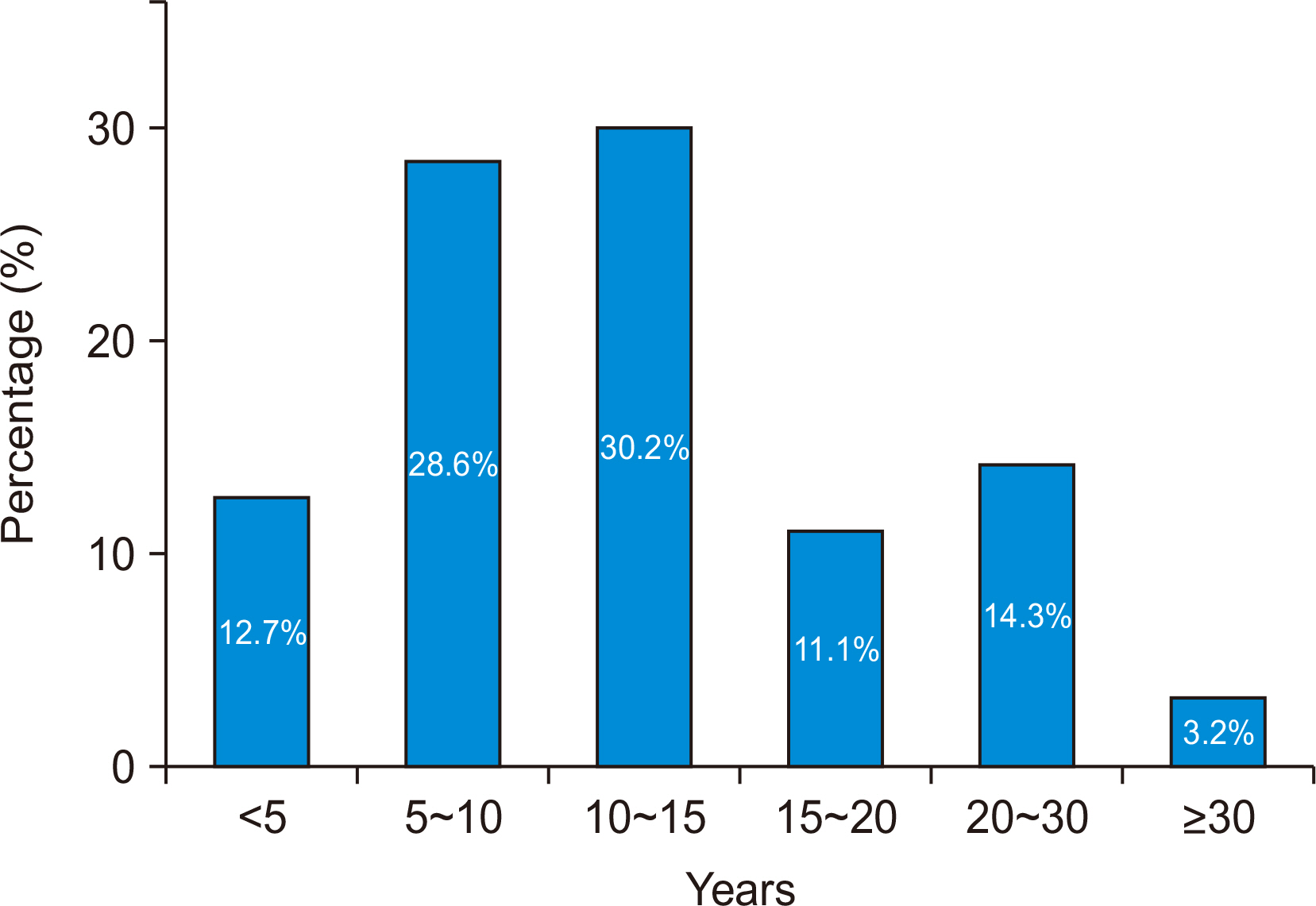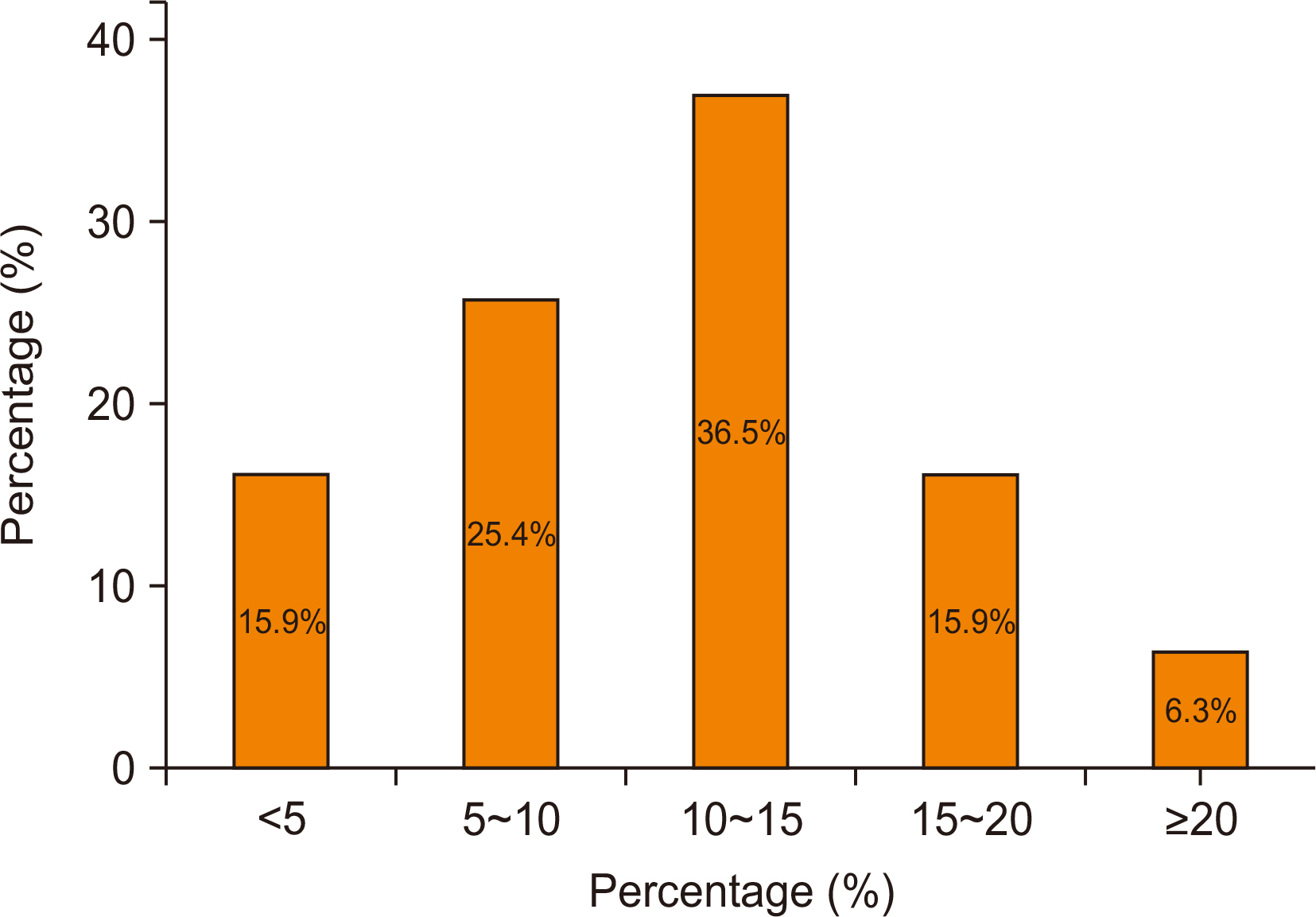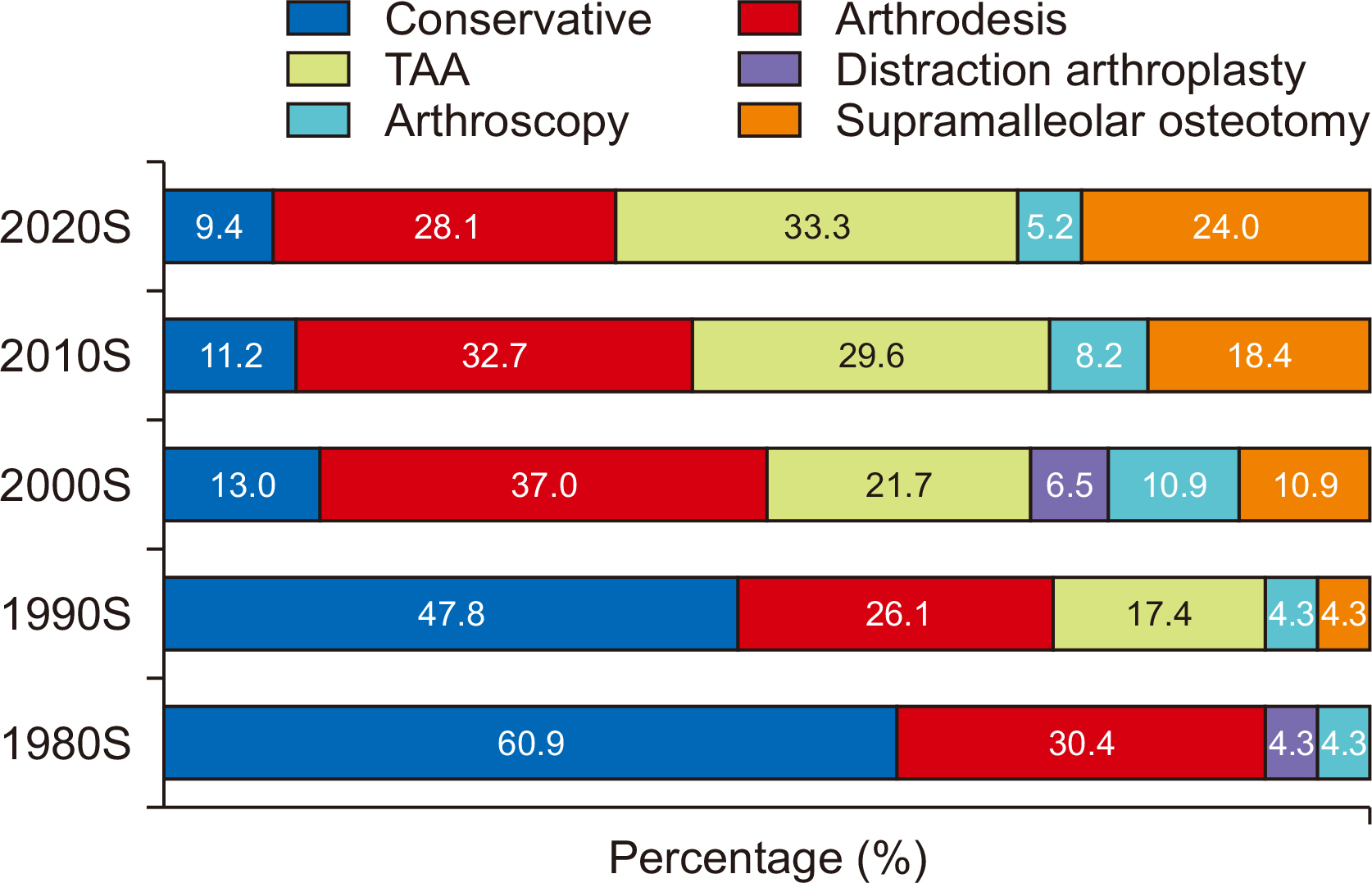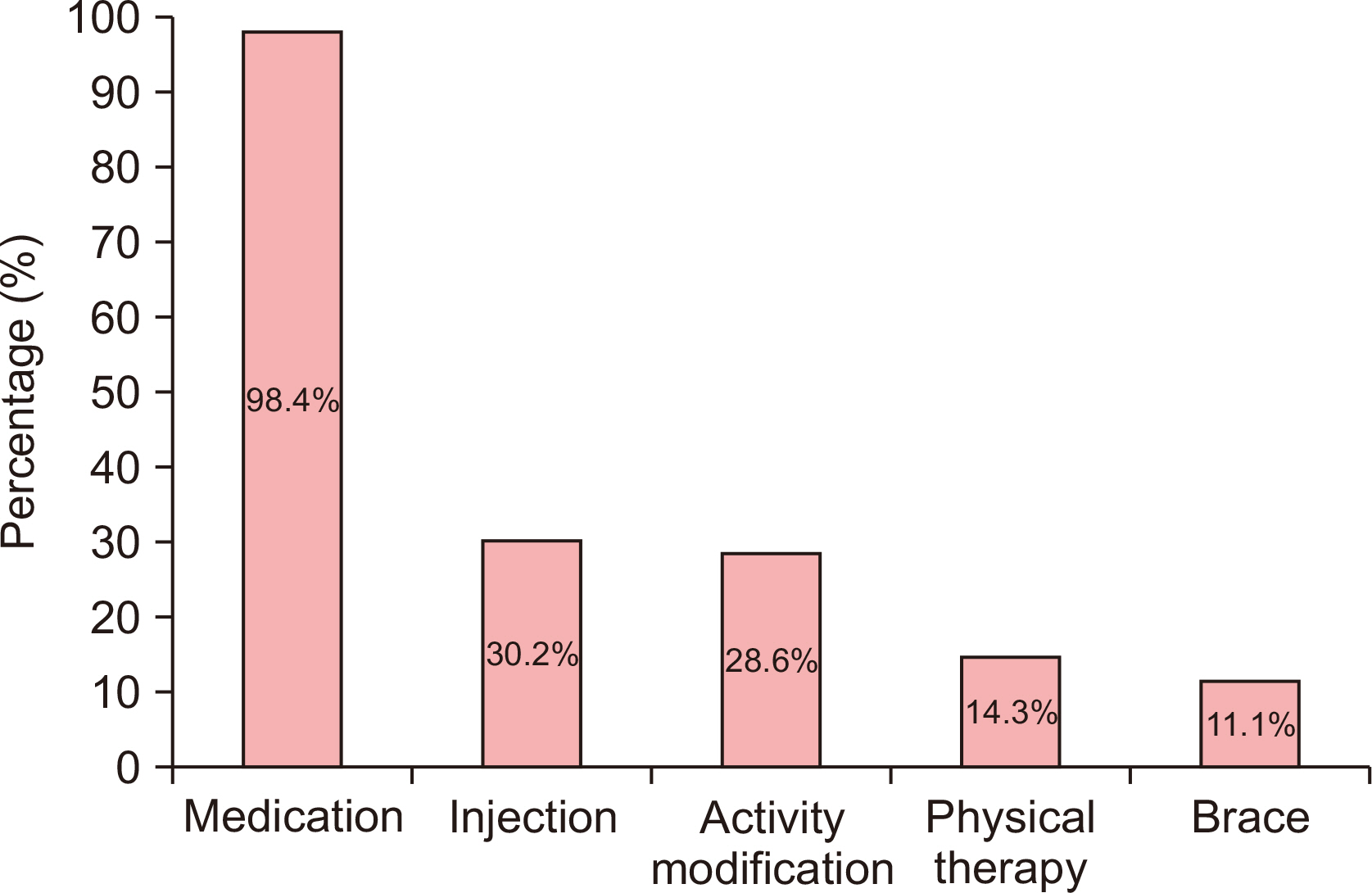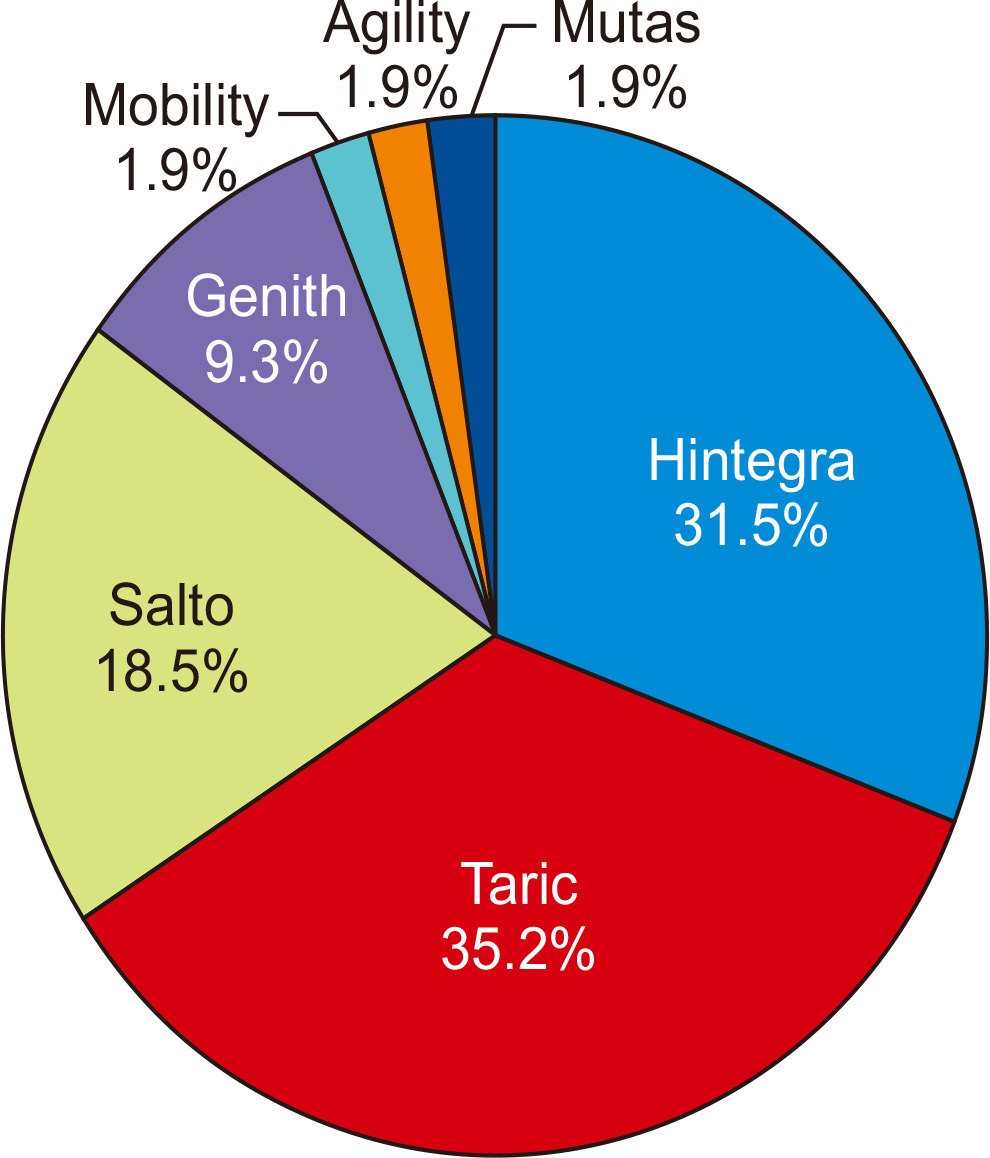J Korean Foot Ankle Soc.
2021 Sep;25(3):111-116. 10.14193/jkfas.2021.25.3.111.
Current Trends in the Treatment of Ankle Arthritis: Analysis of the Korean Foot and Ankle Society (KFAS) Member Survey
- Affiliations
-
- 1Department of Orthopedic Surgery, Chungbuk National University Hospital, Cheongju, Korea
- 2Department of Orthopedic Surgery, Hallym University Chuncheon Sacred Heart Hospital, Chuncheon, Korea
- 3Department of Orthopedic Surgery, Busan Centum Hospital, Busan, Korea
- 4Department of Orthopedic Surgery, Korea University Guro Hospital, Seoul, Korea
- 5Department of Orthopedic Surgery, Inje University Sanggye Paik Hospital, Seoul, Korea
- KMID: 2520101
- DOI: http://doi.org/10.14193/jkfas.2021.25.3.111
Abstract
- Purpose
Variations in the preferred conservative and operative treatment methods for ankle arthritis may be observed in the practice of orthopedic surgeons. This study is based on the Korean Foot and Ankle Society (KFAS) member survey and aims to report the current trend and changes in the management of ankle arthritis over the last few decades.
Materials and Methods
A web-based questionnaire containing 24 questions was sent to all KFAS members in July 2021. The questions were mainly related to the preferred techniques and clinical experience in osteotomy, arthrodesis, and total ankle arthroplasty (TAA) for patients with ankle arthritis.
Results
Sixty-three out of 550 surgeons (11.5%) responded to the survey. The responses to 6 out of the total of 24 questions (25.0%) achieved the levels needed to reflect a tendency. Answers that showed a tendency were related to the following: a surgical approach for arthrodesis (anterior approach), use of auto-bone graft for arthrodesis (iliac bone), a nonunion rate of more than 10% following arthrodesis, main reason related to unsatisfactory results after arthrodesis (nonunion or delayed union), the main reason to change total ankle prosthesis (unstable supply of prosthesis), the unusualness of revision TAA and conversion of fusion to TAA. Diversity was found in several aspects of treatment (degree of experience and satisfaction in supramalleolar osteotomy, fixation method for arthrodesis, preferred TAA prosthesis and longevity, degree of experinece, annual number of TAA operation.
Conclusion
This study proposes updated information with regard to the current trends in the management of ankle arthritis in Korea. Both consensus and variations in the approach to patients with ankle arthritis were identified through this survey. With an increasing preference for TAA, the need for the development of a prosthesis optimized for Koreans and a stable supply of prostheses were the suggestions made by the study.
Keyword
Figure
Cited by 1 articles
-
Surgical Decision and Patient Selection in End-Stage Ankle Arthritis: Total Ankle Arthroplasty vs. Arthrodesis
Jungtae Ahn, Byung-Ki Cho
J Korean Foot Ankle Soc. 2022;26(3):111-117. doi: 10.14193/jkfas.2022.26.3.111.
Reference
-
1. Gougoulias N, Khanna A, Maffulli N. 2010; How successful are current ankle replacements?: a systematic review of the literature. Clin Orthop Relat Res. 468:199–208. doi: 10.1007/s11999-009-0987-3. DOI: 10.1007/s11999-009-0987-3. PMID: 19618248. PMCID: PMC2795846.
Article2. Guyer AJ, Richardson G. 2008; Current concepts review: total ankle arthroplasty. Foot Ankle Int. 29:256–64. doi: 10.3113/FAI.2008.0256. DOI: 10.3113/FAI.2008.0256. PMID: 18315988.
Article3. Nunley JA, Adams SB, Easley ME, DeOrio JK. 2019; Prospective randomized trial comparing mobile-bearing and fixed-bearing total ankle replacement. Foot Ankle Int. 40:1239–48. doi: 10.1177/1071100719879680. DOI: 10.1177/1071100719879680. PMID: 31561727.
Article4. Zaidi R, Cro S, Gurusamy K, Siva N, Macgregor A, Henricson A, et al. 2013; The outcome of total ankle replacement: a systematic review and meta-analysis. Bone Joint J. 95(B):1500–7. doi: 10.1302/0301-620X.95B11.31633. DOI: 10.1302/0301-620X.95B11.31633. PMID: 24151270.5. Hintermann B, Valderrabano V. 2003; Total ankle replacement. Foot Ankle Clin. 8:375–405. doi: 10.1016/s1083-7515(03)00015-9. DOI: 10.1016/S1083-7515(03)00015-9.
Article6. Ahmad J, Raikin SM. 2008; Ankle arthrodesis: the simple and the complex. Foot Ankle Clin. 13:381–400. viii doi: 10.1016/j.fcl.2008.04.007. DOI: 10.1016/j.fcl.2008.04.007. PMID: 18692006.
Article7. Morash J, Walton DM, Glazebrook M. 2017; Ankle arthrodesis versus total ankle arthroplasty. Foot Ankle Clin. 22:251–66. doi: 10.1016/j.fcl.2017.01.013. DOI: 10.1016/j.fcl.2017.01.013. PMID: 28502347.
Article8. Pedowitz DI, Kane JM, Smith GM, Saffel HL, Comer C, Raikin SM. 2016; Total ankle arthroplasty versus ankle arthrodesis: a comparative analysis of arc of movement and functional outcomes. Bone Joint J. 98(B):634–40. doi: 10.1302/0301-620X.98B5.36887. DOI: 10.1302/0301-620X.98B5.36887. PMID: 27143734.9. Singer S, Klejman S, Pinsker E, Houck J, Daniels T. 2013; Ankle arthroplasty and ankle arthrodesis: gait analysis compared with normal controls. J Bone Joint Surg Am. 95:e191(1-10). doi: 10.2106/JBJS.L.00465. DOI: 10.2106/JBJS.L.00465. PMID: 24352777.10. Cody EA, Scott DJ, Easley ME. 2018; Total ankle arthroplasty: a critical analysis review. JBJS Rev. 6:e8. doi: 10.2106/JBJS.RVW.17.00182. DOI: 10.2106/JBJS.RVW.17.00182. PMID: 30153245.11. Stavrakis AI, SooHoo NF. 2016; Trends in complication rates following ankle arthrodesis and total ankle replacement. J Bone Joint Surg Am. 98:1453–8. doi: 10.2106/JBJS.15.01341. DOI: 10.2106/JBJS.15.01341. PMID: 27605689.
Article
- Full Text Links
- Actions
-
Cited
- CITED
-
- Close
- Share
- Similar articles
-
- Current Trends in the Treatment of Diabetic Foot: Analysis of the Korean Foot and Ankle Society (KFAS) Member Survey
- Current Trends in the Treatment of Diabetic Foot: Analysis of the Korean Foot and Ankle Society (KFAS) Member Survey
- Current Trends in the Treatment of Syndesmotic Injury: Analysis of the Korean Foot and Ankle Society (KFAS) Member Survey
- Comparison of Ankle Arthrodesis and Total Ankle Arthroplasty in End-Stage Ankle Arthritis
- Current Trends in the Treatment of Acute Achilles Tendon Rupture: Analysis of the Korean Foot and Ankle Society (KFAS) Member Survey

